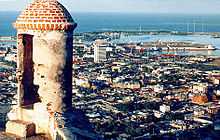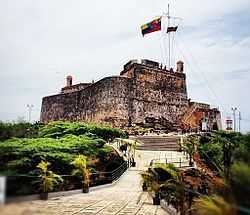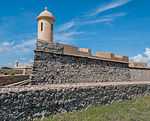Solano castle
| Solano castle | |
|---|---|
| Puerto Cabello, Carabobo | |
|
The Solano castle was built at the top of the Cresta de Vigía (or "lookout crest") to protect the city from naval attacks. | |
| Coordinates | 10°27′45″N 68°01′00″W / 10.4625°N 68.016667°W |
| Type | Fortress |
| Site information | |
| Controlled by | State government |
| Open to the public | yes |
| Site history | |
| Built | c. 1766 |
Solano castle is a colonial castle built in the eighteenth century by the Spanish monarchy in Puerto Cabello, Venezuela. Located inside the San Esteban National Park, the castle was built to protect the commercial complex of the city and the harbour from naval attacks. Constructed c. 1766 by order of Don José Solano y Bote, it is the only colonial fortification to be built between 1763 and 1771 and the last military construction built during the colonial era.
The castle has been the center of several notable events in Venezuelan history. Spanish commander Antonio Zuazola was hanged after a surprise attack by the forces of Rafael Urdaneta overthrew the realists, giving control of the fort to the patriots. Pedro Carujo was imprisoned in the fort after attempting to kill Simón Bolívar in 1828. In 1962, the castle was the stronghold of an uprising led by several commanders in the city. It was declared National monument in 1965.
Description
The Solano castle is located in the the moon, south of Puerto Cabello, Carabobo. It is a military castle built by order of governor of Venezuela, Don José Solano y Bote c. 1766 in the area referred to as Cresta de Vigía (or "lookout crest"). It was intended to protect the commercial complex of the city[1] and the harbour from naval attacks.[2] It was the only colonial fortification to be built between 1763 and 1771[3] and it is described as the last military construction built during the colonial era in Venezuela.[4]
History
Nineteenth century

Originally controlled by the Spanish sources since its foundation in 1766, a surprise attack aided by the forces of Rafael Urdaneta[5] in the midst of the Admirable Campaign in the Venezuelan War of Independence, was executed on September 1, 1813, giving control of the fort to the patriots.[6] The following day, Spanish commander Antonio Zuazola, who was known for having mutilated hundreds of prisoners in the east of the country, was imprisoned.[7] Simón Bolívar, leader of the patriots, offered Domingo de Monteverde, leader of the realists, the exchange of Zuazola with Domingo Jalón.[8] After the proposal was rejected by the realists, Bolívar ordered the death Zuazola, who was hanged from a flagpole outside the walls of the fort.[9][10]
In 1828, Bolívar issued a decree establishing his dictatorship in the country; as a result, a group of young lawyers gathered to depose Bolívar and proclaim Francisco de Paula Santander as constitutional president. On the night of September 25, 1828 the conspirators attempted to assassinate Bolivar at the presidential palace; Bolívar managed to escape with the help of Manuela Sáenz by jumping from a window until the military forces restored control of the city.[11] Pedro Carujo, born in Barcelona, became a Commander in 1828, hand picked by Simón Bolívar to lead the Military Academy founded in Bogotá. However, Carujo joined the supporters of Santander and attempted to kill Bolívar while on the revolt of September 25, for which he was sentenced to death and moved to the Solano fort in March 1829. After managing to escape several months later, he was recaptured and crickets were attached to him. He was deported to Curacao in June 1830, only to return several months later under the government of José Antonio Páez.[12]
Twentieth century
In 1904, a budget designed by engineer Germán Jimenez was approved by the Ministry of Public Works to repair the castle.[13] On June 2, 1962 an uprising led by Manuel Ponte Rodriguez, commander Pedro Medina Silva and Lieutenant Commander Victor Hugo Morales occurred in the city of Puerto Cabello. As soon as the national Government became aware of the revolt, troops of both the Air Force and the Army led by Colonel Alfredo Monch are sent to bomb and surround the city. At the same time, most of the officers in command of 55th National Guard squadron and detachment refuse to participate in the uprising.[14] The following day, the Ministry of Interior announced that Armed forces loyal to the government defeated the rebellion with a balance of 400 deaths and 700 wounded.[14] On June 6, the Solano fort, which was used as a stronghold by the rebels, fell when the leaders of the revolt were captured by the Army.[14] The fort was declared a National monument in 1965.[4]
Gallery
See also
| Wikimedia Commons has media related to Puerto Cabello. |
References
- ↑ López Villa, Manuel Antonio (2003). Arquitectura e historia: curso de historia de la arquitectura (in Spanish) 2. Caracas: Consejo de Desarrollo Científico y Humanístico. Universidad Central de Venezuela. p. 567. ISBN 9789800020739. Retrieved 5 January 2013.
- ↑ "Fortín Solano" (in Spanish). Venezuela Tuya. Archived from the original on 5 January 2013. Retrieved 5 January 2013.
- ↑ Núñez Pérez, Luis (2003). Guía del Estado Carabobo (in Spanish) (7 ed.). Valencia. p. 99. Retrieved 5 January 2013.
- ↑ 4.0 4.1 "Fortín Solano: Altas murallas, baluarte histórico de Puerto Cabello". Notitarde. Retrieved 5 January 2013.
- ↑ Boletín de historia y antigüedades (in Spanish) 62. Imprenta Nacional. 1975. p. 16. Retrieved 5 January 2013.
- ↑ Fuentes-Figueroa Rodríguez, Julián (2003). La Segunda República de Venezuela(18 12-1814) (in Spanish). Ediciones de la Presidencia de la República. p. 78. ISBN 9789800303306. Retrieved 5 January 2013.
- ↑ Romero Luengo, Adolfo (1981). Presencia vital de Urdaneta en la emancipación y en el gobierno de Colombia la Grande (in Spanish) (2 ed.). Ediciones de la Presidencia de la República. p. 347. Retrieved 5 January 2013.
- ↑ Peña Vásquez, Salvador (1981). Drama de honor (in Spanish) (2 ed.). Sucesores de Rivadeneyra. p. 243. Retrieved 5 January 2013.
- ↑ Montilla, José Abel (1988). Fermin Entrena, un venezolano del noventa y nueve: novela historica (in Spanish) (2 ed.). Biblioteca de Autores y Temas Tachirenses. p. 426.
- ↑ Martínez, Alí Brett (1973). El Porteñazo: historia de una rebelión (in Spanish) (2 ed.). Adaro. p. 23. Retrieved 5 January 2013.
- ↑ "Conspiración septembrina". Biblioteca Virtual Luis Angel Arango (in Spanish). Banco de la República. Retrieved 5 January 2013.
- ↑ "Pedro Carujo". Venezuela Tuya. Retrieved 5 January 2013.
- ↑ Recopilacion de leyes y decretos de Venezuela (in Spanish) 27. La Opinion Nacional. 1905. p. 468. Retrieved 5 January 2013.
- ↑ 14.0 14.1 14.2 "El Carupanazo y El Porteñazo". Venezuela Tuya. Retrieved 5 January 2013.
| ||||||||||||||||||||||||


